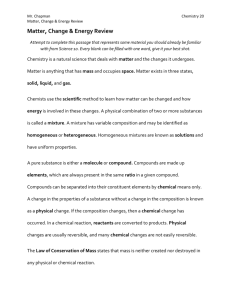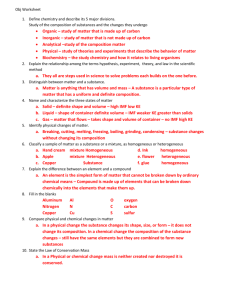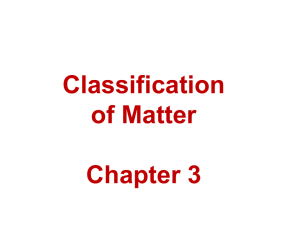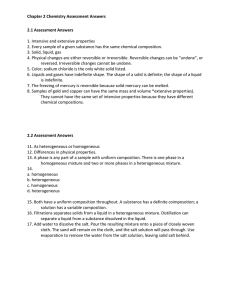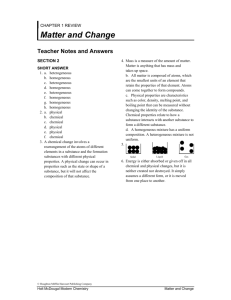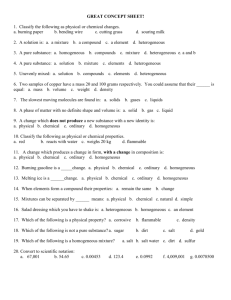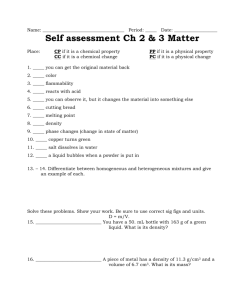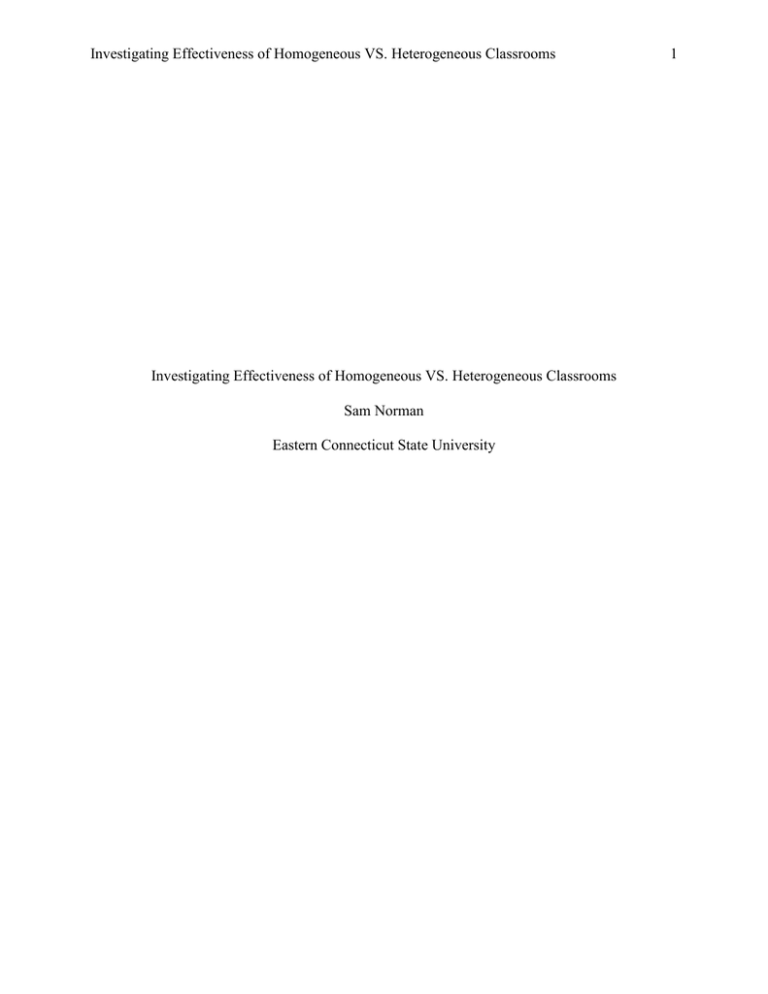
Investigating Effectiveness of Homogeneous VS. Heterogeneous Classrooms
Investigating Effectiveness of Homogeneous VS. Heterogeneous Classrooms
Sam Norman
Eastern Connecticut State University
1
Investigating Effectiveness of Homogeneous VS. Heterogeneous Classrooms
2
Introduction
Many secondary education facilities use a track system to enroll specific classrooms.
Each class subject is broken down into three general skill levels: remedial, college preparatory,
and honors, called homogeneous classrooms. Bacon Academy is one such institution. At Bacon
Academy, a public high school, faculty have recognized that English reading scores in CAPT
and SATs have declined in each of the previous five years. This decline is more prevalent in the
male student body. In addition, student interest in reading has also decreased. One theory that
has been presented is that males are less interested in reading due to low-interest subject matter
due to the generic curriculum in place. The English department has proposed that classes go
from a general class/class curriculum to electives that students of any ability level can sign up for
(heterogeneous classroom setting). For example, instead of “senior English”, students could sign
up for “science fiction”, "mystery", or any number of other specific classes. This change would
necessitate a switch from homogeneous to heterogeneous type classrooms.
Operational Definitions
Tracking: Using a particular method or methods to group students according to ability
level.
Homogeneous classroom: Using data from tracking methods to group like-ability
students in a single classroom setting.
Heterogeneous classroom: Grouping students with a wide range of ability into the same
classroom.
Lexile: The numeric representation of an individual’s reading ability or a text’s
readability.
Purpose of Study
The purpose of this study is to evaluate the educational impact of converting from a
homogeneous classroom setting to a heterogeneous based one. Although there has been research
Investigating Effectiveness of Homogeneous VS. Heterogeneous Classrooms
3
done to the effectiveness of each style of classroom setting, one of the issues in that I wish to
address is the fact that although this topic has been hotly debated for decades,(Dar, 1981) there
seems to be a dearth of studies in secondary educational settings, to prove or disprove opinions.
In one such study, the researcher Erik Roelofs, seems to conclude that heterogeneous
classes improve scores across ability levels. This conclusion defies most elementary and middle
school results. It is my wish to learn if the conclusions were due to the difference in educational
models found in the Dutch system.
My study will contribute to existing knowledge by adding to the sparse body of work of
this subject matter.
Research Questions
1. Do low achieving English students improve test scores in heterogeneous classrooms
compared to homogeneous ones?
2. Do high achieving English students suffer lower grades/test scores due to this change in
curriculum philosophy?
3. Do male students regain scores at the same or greater rate than females from the change,
assuming that there are gains at all?
4. Do student attitudes of reading improve in a heterogeneous setting?
Literature review
This review goes in chronological order and follows a study-by-study review
methodology.
Study one
Investigating Effectiveness of Homogeneous VS. Heterogeneous Classrooms
4
This study, conducted in 1992 by Ellen Fiedler-Brand et al, attempts to study the effects
of tracking (homogeneous classrooms) on gifted students. The researchers examined two middle
schools within the greater Chicago area. In one of the schools, the curriculum included a pull-out
gifted program in an otherwise heterogeneous classroom. The other school was strictly a
heterogeneous setting. The specific topic relevant to student achievement was the research
question whether or not removing gifted students from otherwise heterogeneous class room
settings take away a role-model for other students, and does said removal lower achievement
within the mainstream classroom. (Fiedler-Brand, 1992)
A self referenced limitation on this study was that the social-economic statuses of the two
schools was very different in that the school that did not have the pull out program didn’t
because of lack of funding for their particular school district. (Fiedler-Brand, 1992) Data was
collected using yearly state-wide content mastery testing, and the two schools achievements
scores were compared with identified gifted student’s scores separated from other students.
Results from the study showed that the presence of gifted students in an otherwise
heterogeneous classroom did very little to influence student outcomes. (Fiedler-Brand, 4)
However, an unexpected outcome of the study was to find that identified gifted students lowered
their achievement gains while grouped with lower ability students. This outcome was not fully
developed, and it was indicated that further study and/or confirmation of that outcome was
needed. In conclusion the study seems on it’s face value a valid one, however the obvious
differences in socio-economic backgrounds between the two schools is troubling, and could have
caused the variables to be too inconsistent to draw valid conclusions.
Study two
Investigating Effectiveness of Homogeneous VS. Heterogeneous Classrooms
5
In this twenty four page report published in 1995, Erik Roelofs analyses his study of
Dutch secondary students between the years 1992-1994. An element that was striking in this
study was the approach of the researchers. They felt that previous research failed to consider two
important elements in the classroom, actual time used in teaching core skills, and student’s time
on task from this instruction. “In many Dutch studies actual classroom behavior is often either
ignored or assessed by means of questionnaires. By contrast, the present study focuses on
teaching and learning processes as observed in the classroom.” (Roelofs 1995)
To combat this perceived lack, the researchers used a multi-pronged approach in
gathering their data. The researchers used direct observation in a very systematic way to
quantify on-task and off-task behavior. In addition they used questionnaires to assess teacher
attempts at task differential between differently-abled students.
This study of twenty-five teachers in three different schools, attempted to greatly limit the
dependant variables, or at least account for them as much as possible. For example, observers
frequently revolved to the different teachers to limit observer bias. Observers were also strictly
timed in their roles. The observations were limited in responses, on-task, off-task for students,
management, teaching, non-teaching check boxes for educators. (Roelofs 1995)
One stated limitation was an unforeseen curriculum change in the third school, which
converted from a homogeneous environment to a “tiled” hybrid style classroom. However the
author clearly states and differentiates this change within the data to mitigate this limitation.
The author concludes that there is a high correlation between time spent managing and
teaching new subject matter and classroom setting. Homogeneous class spend twice the amount
of time learning new material and spent significantly less time in classroom management.
(Roelofs 1995)
Investigating Effectiveness of Homogeneous VS. Heterogeneous Classrooms
Study three
This 1995 study by Linda Casey targets a school system that had converted it’s
educational philosophy to a heterogeneous environment. The problem was stated that although
lower ability students were seeing a rise in test scores and grades, upper level students were
feeling unmotivated, bored, and unchallenged. This preliminary data was collected through the
use of questionnaires, analyzing test scores, interviews of teachers and observations. “The
targeted students at the extreme ends of the ability range in heterogeneous high school
classrooms exhibit a lack of achievement.” (Casey, 1995)
The author used 1500, all female, students in her study of a Catholic middle school
education community. Her experimental study tried four specific strategies to improve student
outcomes. She measured the effectiveness of these strategies by administering the Cornell
critical thinking test as both a pre and post test. The author used a control group to develop a
base, and several other groups using a mixture of the four strategies.
According to the author a limiting factor became “time”. Because of some unforeseen
circumstances, the number of interactions as well as the length of the study had to be lowered.
Regardless of the above limitation, scores from all groups other than the control group went up
from between four to nine points on a sixty eight point scale. This improvements was deemed
significant for lower achieving students and low to moderate for high achieving students.
Ironically, students in the study groups wrote that they did not believe these new strategies to be
effective.
The author concludes that in heterogeneous classrooms specific teaching techniques and
strategies (such as the four tested in her study) needed to be implemented for students at both
ends of the academic range.
6
Investigating Effectiveness of Homogeneous VS. Heterogeneous Classrooms
7
Study four
The next study, published in 2002, is actually a meta-study/report of 118 studies
completed since 1984. The study synthesis completed by Zoe Barley et al,… grouped the studies
into six general categories. One of the categories was "grouping structures" and is directly
relevant for this lit. review. Eighteen studies fell into this category. The researchers had
preconceived understanding of the homogeneous classroom. "the use of tracking has led to a
lower standard for some students..."(Barley, 2002)
The collated studies, not unsurprisingly, (from the bias shown in the introduction of this
study) show that mixed groupings can be effective in increasing the achievement of lowachieving and at-risk students. Since the focus of the studies were to track progress in low
achieving students, the impact of the high achieving students is not addressed, positive or
negative. It is telling, however, that of all the studies in this subgroup, only one was from a
secondary institution, and that study was the one that resulted in mixed results. As written
earlier, very few comprehensive studies have been completed at the secondary level. In none of
the studies dedicated to homogeneous groupings were the participants in high school.
Summary of Literature review
There still is a lot of disagreement and uncertainty regarding this topic comparing
homogeneous and heterogeneous classrooms. Two of the four seem to recommend that
heterogeneous settings are preferred, but the study by Erik Roelofs, disagrees, his research
indicates stronger student outcomes in a homogeneous setting. In one of the three other studies,
the one by Casey, concludes that heterogeneous groupings are beneficial only when teachers are
properly trained in specific strategies to promote that kind of setting. Each of the other two
researchers also comment to the fact that high achieving students achieve lesser gains and can
Investigating Effectiveness of Homogeneous VS. Heterogeneous Classrooms
8
even suffer regression in attitudes towards school in heterogeneous settings. One weakness in the
topic is that very little work has been completed in secondary education; a vast majority of the
studies focus in elementary and middle school settings. The few mentioned here are among just
a handful of studies done. Considerably more research needs to be done with secondary
education as the focus for any consistent, reliable conclusions made.
Research Design
This will be a correlational study in which students will be tracked over the course of
their high school career. At the beginning of their freshman year and the end of each school year
in their sophomore, junior, and senior years, subjects will take a
Pearson/Longman/PrenticeHall:MyReadingLab reading test to measure reading levels graded on
the Lexile scale. Subjects' standardized Lexile scores as well a response to a questionnaire
regarding attitudes about reading will be measured and compared after their sophomore, junior,
and senior years.
Students entering Bacon Academy will take the Lexile test to establish a base line score.
They will also answer a questionnaire regarding their independent reading habits and attitude
towards reading. At Bacon Academy, freshman and sophomore years are taught
heterogeneously in the English department. The school is preparing to have junior and senior
years taught homogeneously, with a series of elective classes. Student gains in actual reading
ability as well as attitude towards reading will then be measured at the end of the sophomore
year (end of heterogeneous classes) and end of junior and senior years.
There is a serious internal threat of validity that can be identified within this study. This
threat is that different teachers will be teaching over the course of the subject's high school
Investigating Effectiveness of Homogeneous VS. Heterogeneous Classrooms
9
study. Differences in teaching styles and curriculum choices can/will skew results. There is no
realistic way to mitigate this threat.
Unfortunately, Bacon Academy has a fairly homogeneous student base, ethnically as well
as socio-economically speaking. Of the approximately one thousand students, only
approximately three percent are of an ethnic minority. This limited cross section could limit
external validity to other schools with similar socio-economic and/or minority student bodies.
Sampling
The subject school has approximately two hundred and fifty students in each year. It is
my intention to use all students in a given year, but then ultimately remove any students not
present or tested during all three years of the study. Every effort will be used to get one hundred
percent participation in the testing, due to the fact that this test is already given, and part of the
curriculum, it should not be overly difficult to use this data. Any loss in the sample size should
be attributable to attrition, and not participation loss. I hope to have at least one hundred and
fifty subjects by the end of the study.
Measures
I will be measuring two different data sets simultaneously: first, a student's
attitude/willingness to read in the form of a questionnaire, and secondly their corresponding
lexile score.
The questionnaire will consist of structured item questions with a standard scale of
"strongly agree" to "strongly disagree" for the participants to choose from. I will also be tracking
the gender of the subject, year of study, courses taken.
Investigating Effectiveness of Homogeneous VS. Heterogeneous Classrooms
10
The Lexile measures student ability to decode and comprehend texts. It is a sliding scale
with four broad catagories and range within each catagory. The catagories are: basic, below
grade level, grade level, and advanced.
Data analysis procedure
After each year and at the conclusion of the study, I will attempt to relate the correlation
of student attitude of reading and gains in their Lexile score. I will do this by graphing changes
in their questionnaire as well as changes in their Lexile scores. I will be looking for relative
(positive or negative) changes in their scores and attitude while in a homogeneous class and
changes while in a heterogeneous one.
Ethics and Human Relations
There should be no ethical issues or human relations problems in this study since all
standardized test scores are routinely given to teachers to view. Any questionnaires are
confidential and names of participants will not be publicized in any way.
Timelines
Incoming freshmen (2011) take the on-line Pearson/Longman/PrenticeHall Lexile test
during the first week of September, during one of their English classes. This test takes
approximately twenty minutes. During the same class, students will take a questionnaire survey
using "Survey-Monkey". I anticipate this survey to take approximately ten minutes. At the end
of each year of their sophomore, junior and senior class will repeat the survey and test. In the
past, it has taken about a week to test the entire class. It should take approximately a month to
collate the data, and track it graphically at the end of each testing cycle.
Investigating Effectiveness of Homogeneous VS. Heterogeneous Classrooms
Works Cited
B a r l e y, Z , L a u e r , P , A r e n s , S , & A p t h o r p , H . O f f i c e o f E d u c a t i o n
Research and Improvement, (2002). Helping at -risk students meet
standards (ed-o1-co-0006). Washington, DC: EDRS.
C a s e y, L . 1 9 9 5 . A d v a n c i n g a c a d e m i c a c h i e v e m e n t i n t h e h e t e r o g e n e o u s
classroom. (doctoral dissertation). Retrieved from ERIC (ED400073)
Dar, Y, & Resh, N. (1981). Homogeneity and heterogeneity i n education.
interaction between personal resources and the learning environment
in the effect on scholastic achievement. . Jerusalem, Israel: Hebrew
U n i v e r s i t y.
Roelofs, z. (1995). Class heterogeneity & adaptive teaching in dutch
secondary education. Proceedings of the Annual meeting of the
american educational research association (pp. 23). San Fransisco:
(ED392834)
Schindelmar, L, & Szoo, J. Clinton, CT. Board of Education, (1991).
What is the impact of heterogeneous grouping versus homogeneous
grouping on secondary school student performance? (ed-349 305).
Clinton CT:
11



